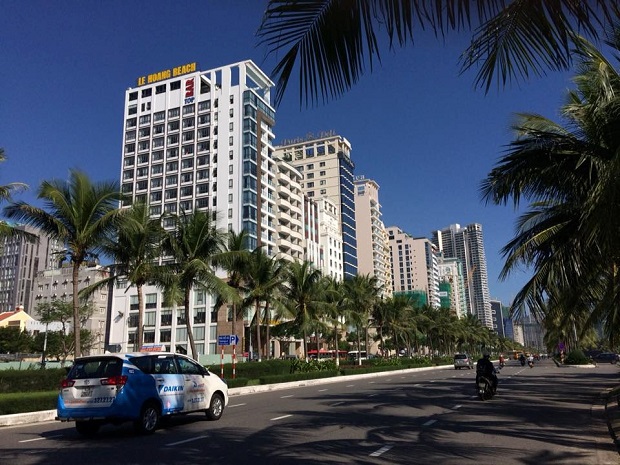City eyes luxury vacation destination in paradise for visitors
As of late September this year, Da Nang had a total of 752 accommodation establishments. Of this figure, 74 are 4 and 5-star with 15,218 rooms in total, and they are along coastal streets in Ngu Hanh Son and Son Tra districts such as Pham Van Dong, Vo Nguyen Giap, Hoang Ke Viem, Tran Bach Dang, Ngo Thi Si, and Ha Bong.
 |
| Some hotels on the Hoang Sa-Vo Nguyen Giap-Truong Sa seaside route |
The majority of such hotels and resorts are under the management of international groups, including AccorHotels, InterContinental Hotels Group, Hyatt Hotel Group, Marriot Hotels, Serenity Holding, Japan's Route Inn Group, Spanish SBH Group, and Hilton Hotels and Resorts Group.
The annual room occupancy rates in such establishments reach between 75% and 80%.
These positive results have been mainly attributed to great efforts have made by these hotels’ managers in enhancing their service quality and increasing their competitiveness both at home and abroad.
In addition, the hotels’ staff members have been methodically trained to enhance their professionalism, and foreign language, customer caring, communication and behavior skills.
Notably, advanced techniques and information technologies have been applied into the operation and management of these hotels. Facilities and equipment have been maintained regularly.
In addition to international management groups, some reputable Vietnamese groups have invested, managed and operated high-end hotels and resorts in the city. Included are Vingroup (Vinpearl), Muong Thanh Corporation (Muong Thanh Hotel), and H&K Hospitality (Royal lotus and Bell Maison).
These hotels operated by Vietnamese groups have showed the effective operation over recent years.
Mrs Truong Thi Hong Hanh, Deputy Director of the municipal Tourism Department, said most of luxury beach hotels and resorts have met international standards, and they have better designs, and more high-class facilities than those in Thailand, Singapore and Japan.
She added that many hotels and resorts have received prestigious awards.
In particular, the InterContinental Danang Sun Peninsula Resort was honoured with the ‘Asia’s Leading Luxury Resort’ awards for 4 consecutive years from 2014 - 2017. Operated by Empire Group, the Naman Retreat won the ‘Asia's Leading Retreat’ awards for 2 consecutive years in 2016 and 2017.
In 2017, the Furama Resort Danang won two trophies namely the ‘Luxury Ocean View Resort’ and the ‘Luxury Wedding Destination’ at the prestigious World Luxury Hotel Awards in St. Moritz, Switzerland.
According to a report released by Savills, Viet Nam's largest real estate services provider, the number of such establishments will continue increasing as there are numerous hotels and resorts currently under construction across the city. By the end of this year, more 2,300 hotel rooms in the 4 to 5-star hotel segment will be put into use.
Mr Dinh Van Loc, Director of the city-based Viet Da Tourism Company, pointed out some shortcomings in the operation of accommodation establishments in the city.
In detail, the current number of luxury hotels and resorts in the city has only met the demand for accommodation from domestic and foreign visitors in normal days. However, this figure cannot meet the demand of visitors during such peak occasions as Tet, Da Nang International Fireworks festivals, and other national public holidays.
In addition, the rental prices of luxury hotels and resorts in the city are much higher than those in Asian countries, including Thailand.
Recently, many visitors have preferred to stay in 4 to 5-star hotels and resorts due to good services and acceptable prices. Therefore, recent years have seen a slight decrease in the number of visitors staying in 1 to 3-star hotels.
Mr Loc, therefore, stressed the need for relevant agencies to exploit suitable guests for 1 to 3-star establishments, with a focus on international visitors to the city by road on the Viet Nam-Laos-Thailand-Cambodia route, and domestic ones in the city’s neighbouring localities, Ho Chi Minh City, and Ha Noi.